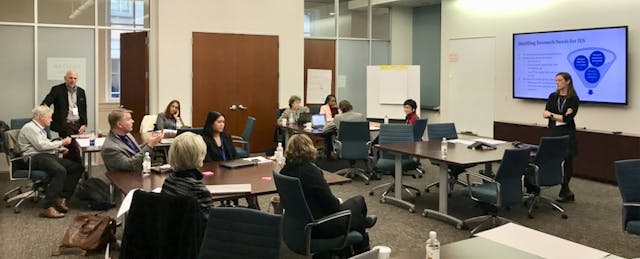Like U.S. taxpayers trying to make sense of the federal tax code, many educators feel that education research is inaccessible and not written in a way they can understand.
The resulting chasm creates a problem for educators, who may not be using or incorporating research-backed teaching practices into their instruction. It’s also a problem for the research groups whose primary audience are working educators.
During a day-long event on Tuesday in Washington, D.C., educators and researchers tried getting to the bottom of the issue, which they summed up as a translation problem. Then they came up with some actionable steps that could help solve it.
The event, organized by the Institute of Education Sciences (IES)—the U.S. Department of Education’s independent research arm—and the nonprofit Jefferson Education Exchange (JEX), brought together IES staff and representatives from more than 50 education associations to brainstorm how they can better elevate the educator voice in research that is produced for and about them.
Ahead of the D.C. event, the IES and JEX met with educators in Raleigh, N.C., and Omaha, Neb., to better understand the problem. The groups also surveyed 510 educators about their views on research in the field today.
Here’s what they’ve learned so far (note: these findings are preliminary and the survey remains open).
- While the vast majority of educators say they find education research useful, reliable and relevant, more than 40 percent of those surveyed do not believe that research is easy to find, understand or transfer into their practice.
- Most educators access information about their profession through online searches, social media, colleagues, supervisors, their professional association or a journal subscription.
- Respondents are relatively unfamiliar with the IES—the federal government’s primary education research body. More than half said they’d never heard of three of the six IES sources, which include the Education Resources Information Center, National Center for Education Research, National Center for Education Statistics, National Center for Special Education Research, What Works Clearinghouse and Regional Education Laboratories. Few have used any of the sources.
- Nearly 80 percent of those surveyed agree that educators should influence the topics covered in education research.
- After participating in the Omaha and Raleigh discussions, most of the 140 educators who attended expressed strong interest in participating in research, communicating their research needs to research bodies and/or co-designing research.
- In particular, educators want to see more research about technology, trauma and mental health, equity and educator talent.
For most of the day, education leaders broke into groups and got to work.
“We’re only going to get to the root of these problems if we think about them together,” said Doug Paulson, director of academic standards at the Minnesota Department of Education, who participated in the event on behalf of the Council of State Science Supervisors.
His statement echoed the thoughts of others in attendance, who repeatedly said that the conversations Tuesday were a great starting point.
Many attendees were representatives from associations working on behalf of education technology, students with disabilities, military children, school librarians, rural students, content specialists, principals and superintendents, among others. Those reps put their heads together to understand their members’ research routines and involvement, and ultimately came up with a few concrete steps they and the IES could take to bridge the gap between educators and education research.
Here are some of the ideas they proposed for the IES:
- Create a process or “toolkit” to help associations define the needs of their members.
- Provide simpler, more digestible language for associations to use with their members about new research, including how to communicate over social media.
- Explicitly work with educators to determine research questions and actively involve educators in the work that comes from that.
- Establish a set group of associations that gather regularly to discuss the research needs of educators.
- Invite educators to share ideas with the IES directly, either through a Twitter hashtag or an email domain (the example given was #researchideasIES or researchideas@ies.gov).
Here are some of the ideas they proposed for education associations:
- Create resources to train undergraduates—essentially the “educators in training”—on understanding, using and vetting research.
- Raise awareness about existing IES resources with members.
- Formalize relationships among associations by appointing one person at each organization to be a liaison between other education associations and the IES.
- Invite the IES to present and/or conduct learning sessions at annual conferences.
Researchers from the IES joined breakout groups where these ideas were discussed and openly provided feedback as the conversations were happening. At the conclusion of the event, they said they appreciated the suggestions and would take them into account.
Whether that will happen—and how quickly—remains the biggest question.


